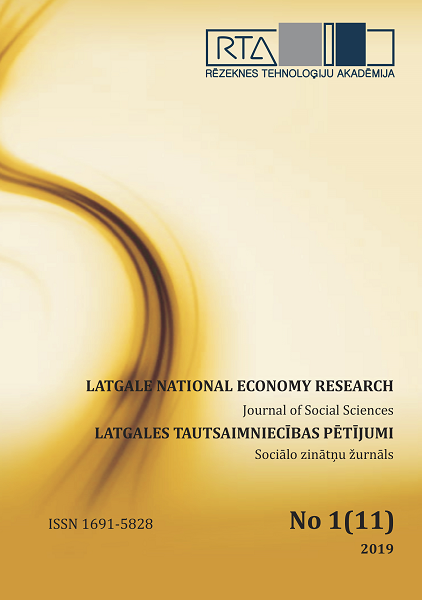ASSESSMENT OF MAIN LIST STOCKS AS AN INVESTMENT OBJECT IN THE BALTIC REGULATED MARKET
DOI:
https://doi.org/10.17770/lner2019vol1.11.4319Keywords:
stock market, investment, assessment, main listAbstract
The stock market, which could be seen as one of the types of securities market, is an unstructured environment in which every investor needs to understand how to invest. For a potential investor interested in shares as one of the objects of investment, it is possible to buy the shares and potentially earn despite the fact that an investment in shares is considered to be a very high-risk investment. The research aims to assess Baltic Main List stocks as an investment object in the Baltic regulated market. The research results showed that investors should assess and invest in the companies of the Baltic Main List on Nasdaq Vilnius and Nasdaq Riga if they plan to gain income from an increase in share prices and to assess and invest in the companies of the Baltic Main List on Nasdaq Tallinn and Nasdaq Riga if they plan to earn income from dividends. The author concludes that the use of an investment account has not been sufficiently popularised among individuals, which does not contribute to the development of savings culture in Latvia and in the other Baltic States. For the education of private investors and the promotion of making decisions on share purchases, it would be desirable for investors to offer summarised information on company shares and their characteristics on the Nasdaq website. The research employed general quantitative and qualitative methods for economic research, including comparative analysis and synthesis, statistical analysis and graphic analysis.
References
Apinis. M. (2015). Biržs vilina ar peļņu. Ifinanses. aprīlis. Nr.1. 36.-39.lpp.
Capital.com (2018). Akciju indekss. Pieejams: https://capital.com/lv/akciju-indekss-definicija
Cochrane. J.H. (2011). Presidential address: discount rates. Journal of finance. 66. 1047-1108. Retrieved from: https://ej.uz/fpm9
Danns. F. (2006). Ieguldījumu akcijās vērtēšana (1.daļa). Finansists. 1 (13). 12.-13.lpp.
Grigorjeva. J. (2008). Baltijas valstu uzņēmumu finanšu rezultātu ticamības ietekmes uz akcijas ienesīgumu novērtēšana. RTU. 112 lpp.
Grišins. J. (2018). Kur zemo depozītu likmju laikā ieguldīt 1000 eiro. Dienas Bizness. 19.06.2018.
Hāka. Ž. (2017). Neizmanto visu potenciālu. Dienas Bizness. 18.12.2017.
InvestingAnswers (2019). Dividend yield. Retrieved from: https://ej.uz/fkaq
Islam. Md.R.. Khan. T. R.. Choudhury. T.T.. Adnan. A.M. (2014). How Earning Per Share (EPS) Affects on Share Price and Firm Value. European Journal of Business and management. 6(17). Retrieved from: https://ej.uz/c5i7
Kaužēns. E. (2018). Kapitāla tirgus Latvijā – trešajā desmitgadē. bet joprojām vājš. Vai ir alternatīvas? Pieejams: https://ej.uz/zfkz
Ķesteris – Mālkalns. R. (2007). Lauksaimniecības uzņēmumu iespējas piesaistīt kapitālu Latvijas akciju tirgū. LLU raksti. 19(314). 37.-53.
Kumar. P. (2017). Impact of earning per share and price earnings ratio on market price of share: a study on auto sector in India. International Journal of Research. Granthaalayah. 5(2). 113-118. DOI: https://doi.org/10.5281/zenodo.345456
Lasmane. A. (2018). Ko paredz ieguldījumu konta režīms? Ifinanses. Maijs
Latvijas iedzīvotāju finanšu pratības stratēģija 2014–2020 (2014). Finanšu pratības mājas lapa. Pieejams: https://ej.uz/qnkg
Nasdaq (2019). Nasdaq Baltijas tirgus. Pieejams: https://nasdaqbaltic.com/market/?lang=lv
Pavlovs. S. (2013). Kad depozīts nesilda. IrNauda Septembris. Nr.5. 52.-54.lpp
Pelane. A. (2015). Akciju tirgotāja ABC. Pieejams: https://ej.uz/dz7q
Sivaramakrishnan. S.. Srivastava.M.. Rastogi. A. (2017). Attitudinal factors. financial literacy. and stock market participation. International Journal of Bank Marketing. 35(5). 818-841. Retrieved from: https://doi.org/10.1108/IJBM-01-2016-0012
Šnepste. V. (2011). Vērtspapīru tirgus Latvijā – attīstības iespējas un problēmas. Latgales Tautsaimniecības pētījumi. Sociālo zinātņu žurnāls. 1(4). 358.-372.
Spriņģis. J. (2016). Veiksmīga akcionāra portfeļa veidošana. IBizness. jūnijs. 23.-26.lpp.
Tsagkanos. A. ((2017). Stock market development and income inequality. Journal of Economic Studies. 44(1). 87-98. Retrieved from: https://doi.org/10.1108/JES-08-2015-0155
Zaremba. A.. Shemer. J. (2018). Is there momentum in factor premia? Evidence from international equity markets. Research in International Business and Finance. 46. 120–130. Retrieved from: https://doi.org/10.1016/j.ribaf.2017.12.002
Zhang. L. (2017). Local equity market participation and stock liquidity. The Quarterly Review of Economics and Finance. 63. 101–121. Retrieved from: http://dx.doi.org/10.1016/j.qref.2016.02.005
Zhong. A. (2018). Idiosyncratic volatility in the Australian equity market. Pacific-Basin Finance Journal. 50. 105–125. http://dx.doi.org/10.1016/j.pacfin.2017.06.010
Žuka. J. (2009). Baltijas akciju tirgus attīstības scenāriji. RTU. 93 lpp. Pieejams: http://ejuz.lv/30ny


